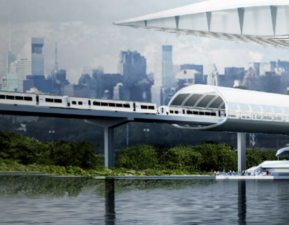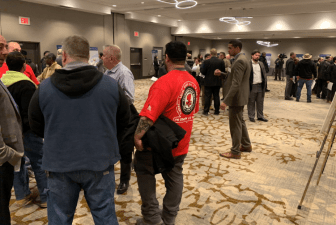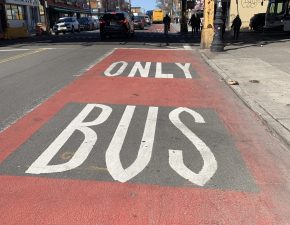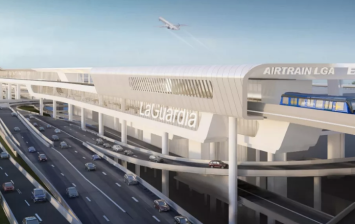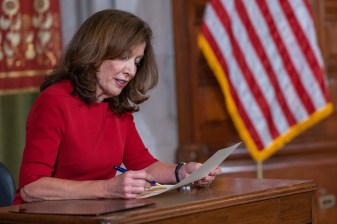Hochul Scraps ‘Wrong Way’ AirTrain for Thrilling New Tech — The Bus!
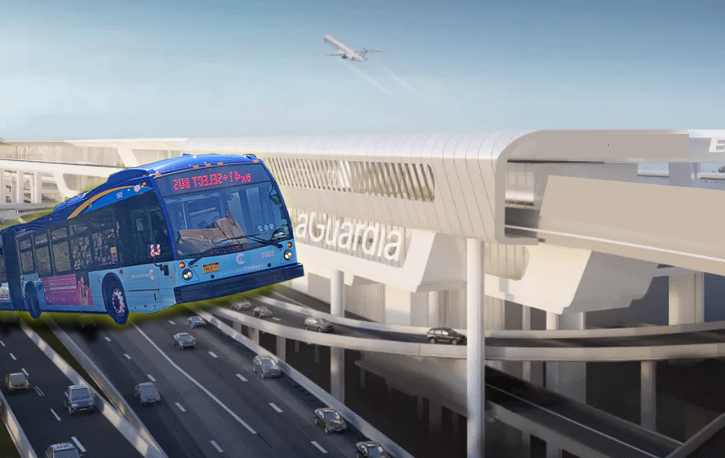
Let’s hear it for the bus.
Gov. Hochul and the Port Authority finally put the kibosh on the notorious Cuomo-era “wrong-way” LaGuardia AirTrain on Monday — promising to move ahead on two new, spruced-up bus connections to the travel hub.
The decision comes 17 months after Hochul formed an expert panel to explore alternatives to former Gov. Andrew Cuomo’s $2-billion proposed monorail, which would have first carried Manhattan-bound travelers away from their destination before requiring them to double-back.
The panel concluded that Cuomo’s light rail proposal would fail to attract more riders than simply expanding an exciting new technology that is akin to a street-based train: the bus.
“The panel did not recommend any light rail options, but advanced bus options that carry equivalent ridership as the former … alignment,” the Port Authority said in a press release.
The panel suggested two separate routes for bus transit that will cost $500 million yet still require buses to contend with regular traffic at several locations, the release said.

One route would run along the existing Q70 Select Bus Service that carries travelers between Terminals B and C and the Woodside Av-61st Street and Roosevelt Av-74th Street subway stations via the Brooklyn-Queens Expressway. To give buses a clearer path, officials said they would add extra space to the BQE to serve as a dedicated bus lane — but leave other, similarly congested parts of the route untouched (see map above).
The other piece of the puzzle would be a new non-stop “bus rapid transit” connection from the Astoria-Ditmars Boulevard subway stop to all three LaGuardia terminals. The panel recommended that the service use electric buses exclusively, as well as transit signal priority and bus lanes on 31st Street and 19th Street (see map below).

The Q70 and new bus from Astoria could serve 3.5 million and 3 million riders per year, respectively, officials claimed.
Right now, the Q70 SBS is free and specifically outfitted for airport service (i.e. it has luggage racks) — and it runs at 12.81 miles per hour, thanks to the portion on that runs on the highway. That speed is faster than the citywide average of 8.72 miles per hour.
But that could change: The panel did not specifically recommend bus-only lanes on Roosevelt Avenue or any of the other pieces of the route, aside from the mile-long portion on the BQE. A possibility that was explored, but not recommended by the expert panel, involved a bus-only lane on the BQE and “a new dedicated busway structure from the BQE to new elevated bus stops on the Airport, allowing buses to completely bypass traffic on the Grand Central Parkway.”
Exactly. The city/state could repurpose existing car lanes to improve travel times to LGA tomorrow — not years from now. https://t.co/r7B2TV8NCT
— Jacob deCastro (@jacob_decastro) March 13, 2023
https://platform.twitter.com/widgets.js
Even though the report noted that the option would have been the fastest for bus riders, it was also deemed the option with the most construction challenges and longest construction window, and was priced at $1.2 billion. On the other hand, the chosen upgrades for the Q70 were priced at a more modest $100 million.
The panel also looked at a pair of other bus rapid transit ideas that connected to the airport. One would have connected the Northern Boulevard N station to LaGuardia with a center running bus lane on Northern Boulevard itself. The report noted that the route itself would have been optimal, but it was ruled out because of conflicts with existing MTA buses that run on Northern and because it “would not be compatible with NYC DOT’s near-term plans to improve road safety and bus services along Northern Boulevard,” according to the report authors.
Another option would have run buses from the Astoria Boulevard station, which itself had three options. Two were of the more expensive, billion-dollar plus possibilities that relied on the same kind of elevated busways the panel rejected for the Q70. A third option out of Astoria Blvd would add bus lanes to Astoria Boulevard on the street but then have the bus mix with general traffic on the Grand Central Parkway.
The so-called bus rapid transit option from Astoria-Ditmars would cost $340 million, according to the report authors, but most of that was not for any street-level infrastructure to keep buses whizzing by cars and taxis. Instead, the price tag includes buying 17 new electric buses, building a new electric bus depot and adding ADA-accessible elevators and escalators to the subway station. It should also be noted that a bus route that is currently parallel to the proposed route — the Q69 along Ditmars Boulevard — has an average speed of just 7 miles per hour in peak hours because it mixes with traffic.
The Q18 along 30th Avenue has an average speed of just 6.44 miles per hour during rush hour.
None of the options are completely locked in yet, so as advocates push for simpler ideas such as simply taking car lanes to improve bus speeds, longtime critics of the AirTrain itself said they’ll be watching to see what happens.
“This is a welcome win for common sense,” said Reinvent Albany Executive Director John Kaehny. “We haven’t seen yet if the bus plan could be improved, but we’re hoping to see a lot of enthusiasm from the MTA and Port Authority to make this something to be proud of.”
Direct train connections to any of the nearby subway stops could attract more riders, but would be logistically challenging, cost $7 billion, and take up to 13 years, according to the expert panel of former Transport for London Commissioner Mike Brown, former New York City Department of Transportation Commissioner Janette Sadik-Khan and Denver International Airport CEO Phil Washington.
The panel said it was “unanimous” in supporting a one-seat ride via subway to the airport, but realized upon further review that any rail solution faced “serious funding and constructability challenges” because of insufficient clearance near the airport and utilities that block tunneling.
All of the bus improvements on the table will cost about $500 million and take between two and five years to finish, which pencils in nicely compared to the light rail options that were priced from $2.4 billion to $6.2 billion.
Choosing a pair of bus rapid transit options to LaGuardia Airport puts an official period on the AirTrain saga that began in 2015 with what Ben Kabak at the time called an “out-of-nowhere” announcement by Cuomo to build a monorail connecting LaGuardia with the Willets Point 7 train and Long Island Rail Road hub.
The proposal was mocked because it proposed to take travelers trying to get to or from Manhattan on a winding path through Queens to get there. The cost ballooned from an initial $500 million to $2 billion by 2020, spurring critics to question the logic of spending gobs of public money given to only serve 23,000 passengers a day by 2045.
Political opposition to the project grew over time as watchdogs and transit advocates asked for a more transparent process and accused the Federal Aviation Administration of ditching any number of alternative ideas to provide an airport connection in order to get behind Cuomo’s idea. Advocates also pointed out that the bus remained a much cheaper and easier solution to the problem of a reliable mass transit solution to LaGuardia. Those same advocates greeted Monday’s news with a celebratory spiking of the football.
“It’s so refreshing to see government leaders admit a mistake and change course before it’s too late,” said Riders Alliance Director of Policy and Communication Danny Pearlstein.
“The backwards boondoggle AirTrain belongs just where it landed, on the scrapheap of history. Much better bus service is the right answer both for Queens riders and the travelers who pass through their neighborhoods on the way to the airport.”
Queens elected officials also began piping up with their objections over the years, from the federal level to the local level. Rep. Alexandria Ocasio-Cortez blasted the FAA’s process that led to federal support for the AirTrain, while State Senator Jessica Ramos said she didn’t believe a word the Port Authority was saying about the project and later cheered a revolt by Port Authority staffers who publicly blasted the idea. While Cuomo himself was unmoved by the projects many critics, once the former governor resigned over allegations of being a sex pest and covering up the state’s role in coronavirus deaths at nursing homes, Gov. Kathy Hochul made an official reconsideration of the AirTrain part of her larger de-Cuomofication process. By March 2022 the Port Authority, whose Chairman Rick Cotton once called the AirTrain the “best, greenest option” out there announced it was looking at a number of possibly better, greener options for airport connections.
Ramos also celebrated the official death rattle of the AirTrain, but also continued to say that the state and city needed to figure out how to match a growing piece of Queens with a growth in mass transit options.
“This is the right move,” said Ramos. “My neighbors who live around LaGuardia deserve transit that is for them, not whatever that boondoggle was. I’m so proud of East Elmhurst for standing up to this bad plan. We still have to look at how to expand transit to those parts of Queens, especially if the proposed football stadium is going to be building what effectively is a new neighborhood in Queens. The 7 alone won’t be able to handle it.”
